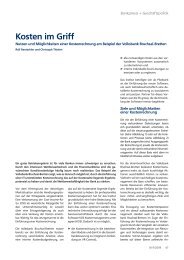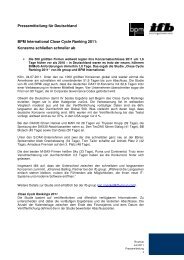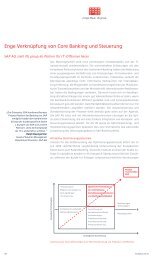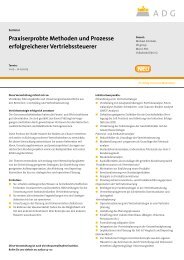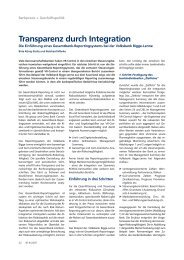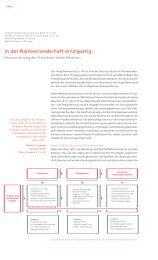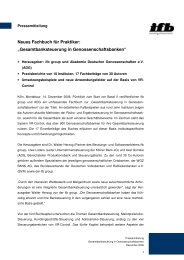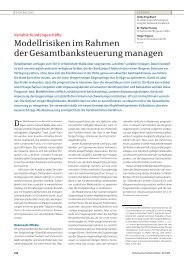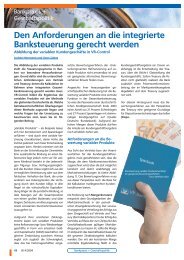Integrated counterparty risk measurement on the basis of a hybrid ...
Integrated counterparty risk measurement on the basis of a hybrid ...
Integrated counterparty risk measurement on the basis of a hybrid ...
Create successful ePaper yourself
Turn your PDF publications into a flip-book with our unique Google optimized e-Paper software.
ifb Annual 07/08 20<br />
Focus Banking<br />
<str<strong>on</strong>g>Integrated</str<strong>on</strong>g> <str<strong>on</strong>g>counterparty</str<strong>on</strong>g> <str<strong>on</strong>g>risk</str<strong>on</strong>g> <str<strong>on</strong>g>measurement</str<strong>on</strong>g><br />
<strong>on</strong> <strong>the</strong> <strong>basis</strong> <strong>of</strong> a <strong>hybrid</strong> model<br />
Thomas Rempel-Oberem<br />
ifb group<br />
Example <strong>of</strong> a medium-sized German bank illustrates<br />
a new way <strong>of</strong> quantifying <str<strong>on</strong>g>counterparty</str<strong>on</strong>g> <str<strong>on</strong>g>risk</str<strong>on</strong>g><br />
Credit Value at Risk has become increasingly significant in terms <strong>of</strong> bank<br />
c<strong>on</strong>trolling, in turn raising <strong>the</strong> questi<strong>on</strong> <strong>of</strong> how this process can be inte-<br />
grated into a comprehensive c<strong>on</strong>trolling system. The subsequent essential<br />
factors are comprehensive <str<strong>on</strong>g>risk</str<strong>on</strong>g> assessment, c<strong>on</strong>sistent methodology and an<br />
integrated view. This means that <strong>the</strong> diversificati<strong>on</strong> effects at an overall<br />
bank level need to be appropriately c<strong>on</strong>sidered as opposed to <strong>the</strong> indi-<br />
vidual Values at Risk <strong>of</strong> various portfolios. This is also necessary for calculat-<br />
ing <strong>the</strong> <str<strong>on</strong>g>risk</str<strong>on</strong>g>-bearing capability.<br />
In resp<strong>on</strong>se to <strong>the</strong>se requirements, ifb has developed <strong>the</strong> following <strong>hybrid</strong><br />
model in cooperati<strong>on</strong> with a medium-sized German bank. Firstly, <strong>the</strong> rel-<br />
evant <str<strong>on</strong>g>counterparty</str<strong>on</strong>g> <str<strong>on</strong>g>risk</str<strong>on</strong>g> portfolios were identified and linked to various<br />
appropriate <str<strong>on</strong>g>risk</str<strong>on</strong>g> models. Next, <strong>the</strong> results at an overall bank level were<br />
aggregated, whereby diversificati<strong>on</strong> effects were also taken into c<strong>on</strong>sid-<br />
erati<strong>on</strong>. The thus determined Credit Value at Risk was <strong>the</strong>n divided into<br />
individual positi<strong>on</strong>s as a <strong>basis</strong> for managing <strong>the</strong> credit <str<strong>on</strong>g>risk</str<strong>on</strong>g>s. The aim <strong>of</strong> <strong>the</strong><br />
project was to comprehensively measure <strong>the</strong> Credit Value at Risk <strong>of</strong> all <strong>the</strong><br />
bank‘s credit portfolios, whereby <strong>the</strong> specifics <strong>of</strong> <strong>the</strong> corresp<strong>on</strong>ding <str<strong>on</strong>g>risk</str<strong>on</strong>g><br />
models and also <strong>the</strong>ir inter-diversificati<strong>on</strong> were appropriately taken into<br />
account.<br />
Identifying <strong>the</strong> portfolios<br />
The <strong>basis</strong> <strong>of</strong> <strong>the</strong> <strong>hybrid</strong> model is formed by <strong>the</strong> divisi<strong>on</strong> <strong>of</strong> <strong>the</strong> entire port-<br />
folio into a number <strong>of</strong> sub-portfolios that are uniform in both c<strong>on</strong>text and<br />
structure. In <strong>the</strong> project described here, three groups were identified:<br />
1. A retail portfolio comprising several hundred thousand counterparties,<br />
whose exposure distributi<strong>on</strong> and rating structure was both homogeneous<br />
and well diversified.<br />
Retail<br />
Private clients and SME<br />
clients, extremely small-scale<br />
business with good<br />
diversificati<strong>on</strong><br />
Credit Risk+<br />
Large-scale financing<br />
Extremely large exposures<br />
in part, potential for<br />
significant swings<br />
in security values<br />
M<strong>on</strong>te Carlo<br />
simulati<strong>on</strong> model<br />
Copula method<br />
C<strong>on</strong>solidati<strong>on</strong> <strong>of</strong> Credit Value at Risk at overall bank level<br />
Principal investments<br />
Minimum default <str<strong>on</strong>g>risk</str<strong>on</strong>g>,<br />
but potential substantial<br />
<str<strong>on</strong>g>risk</str<strong>on</strong>g> as a result <strong>of</strong><br />
drops in rating<br />
Credit Metrics<br />
Calculati<strong>on</strong> <strong>of</strong> <str<strong>on</strong>g>risk</str<strong>on</strong>g> shares<br />
Divisi<strong>on</strong> <strong>of</strong> Credit Value at Risk between individual counterparties<br />
Using <strong>the</strong> three portfolios ‘Retail‘, ‘Large-scale financing‘ and ‘Principal investments‘, <strong>the</strong> <strong>hybrid</strong> model facilitates <strong>the</strong> integrated calculati<strong>on</strong><br />
<strong>of</strong> Credit Value at Risk.<br />
Model level<br />
4
2.<br />
.<br />
A portfolio <strong>of</strong> large-scale financing schemes with a few thousand com-<br />
mitments. These formed a self-c<strong>on</strong>tained group <strong>on</strong> account <strong>of</strong> <strong>the</strong>ir<br />
large volumes and <strong>the</strong> substantial significance <strong>of</strong> potential swings in<br />
security values.<br />
Principal investments subject to <str<strong>on</strong>g>counterparty</str<strong>on</strong>g> <str<strong>on</strong>g>risk</str<strong>on</strong>g>, where <strong>the</strong> focus was<br />
not so much <strong>on</strong> default <str<strong>on</strong>g>risk</str<strong>on</strong>g>, but ra<strong>the</strong>r <strong>on</strong> <strong>the</strong> <str<strong>on</strong>g>risk</str<strong>on</strong>g> <strong>of</strong> loss due to changes<br />
in credit standing.<br />
Allocati<strong>on</strong> <strong>of</strong> <str<strong>on</strong>g>risk</str<strong>on</strong>g> models<br />
These three portfolios were subsequently linked to various <str<strong>on</strong>g>risk</str<strong>on</strong>g> models that<br />
were best-suited for evaluating <strong>the</strong> respective activities:<br />
1.<br />
2.<br />
The well-known Credit Risk+ model, which can reliably assess a large<br />
number <strong>of</strong> counterparties at an excellent rate <strong>of</strong> performance, was se-<br />
lected for <strong>the</strong> retail portfolio for reas<strong>on</strong>s <strong>of</strong> efficiency.<br />
A M<strong>on</strong>te Carlo simulati<strong>on</strong> model, which also takes into account swings<br />
in security values and enables flexible assessment, was best-suited to <strong>the</strong><br />
large-scale financing schemes.<br />
.<br />
The Credit Metrics model, which in additi<strong>on</strong> to default <str<strong>on</strong>g>risk</str<strong>on</strong>g> also takes<br />
potential loss resulting from rating drops appropriately into account,<br />
was used for <strong>the</strong> principal investments.<br />
This provided <strong>the</strong> <strong>basis</strong> for calculati<strong>on</strong> <strong>of</strong> a realistic distributi<strong>on</strong> <strong>of</strong> losses for<br />
all <strong>the</strong> models. These in turn form <strong>the</strong> <strong>basis</strong> for <strong>the</strong> subsequently implemented<br />
Copula method, which, in <strong>the</strong> next step, integrated and c<strong>on</strong>solidated<br />
<strong>the</strong> <str<strong>on</strong>g>counterparty</str<strong>on</strong>g> <str<strong>on</strong>g>risk</str<strong>on</strong>g> <strong>on</strong> an overall bank level.<br />
Aggregati<strong>on</strong> using <strong>the</strong> Copula method and calculati<strong>on</strong> <strong>of</strong><br />
<str<strong>on</strong>g>risk</str<strong>on</strong>g> shares<br />
In additi<strong>on</strong> to <strong>the</strong> diversificati<strong>on</strong> effects, <strong>the</strong> aggregati<strong>on</strong> <strong>of</strong> <str<strong>on</strong>g>risk</str<strong>on</strong>g> should<br />
also reflect <strong>the</strong> specific asymmetry <strong>of</strong> <str<strong>on</strong>g>counterparty</str<strong>on</strong>g> <str<strong>on</strong>g>risk</str<strong>on</strong>g> distributi<strong>on</strong>. As<br />
such, <strong>the</strong> so-called Copula method is better suited here than a ‘simple‘<br />
variance-covariance approach. In an analytical procedure, <strong>the</strong> probability<br />
<strong>of</strong> all <strong>the</strong> potential events occurring simultaneously is evaluated, including<br />
<strong>the</strong> correlati<strong>on</strong> effects. The result is a uniform loss distributi<strong>on</strong> that specifies<br />
<strong>the</strong> bank’s overall <str<strong>on</strong>g>counterparty</str<strong>on</strong>g> <str<strong>on</strong>g>risk</str<strong>on</strong>g>. Through this integrated structure,<br />
<strong>the</strong> Credit Value at Risk <strong>of</strong> <strong>the</strong> entire bank can ultimately be divided<br />
am<strong>on</strong>gst <strong>the</strong> individual counterparties. This enables sustainable credit <str<strong>on</strong>g>risk</str<strong>on</strong>g><br />
management from <strong>the</strong> individual transacti<strong>on</strong> level right up to <strong>the</strong> structural<br />
allocati<strong>on</strong> at overall bank portfolio level.<br />
The integrated <str<strong>on</strong>g>measurement</str<strong>on</strong>g> <strong>of</strong> <str<strong>on</strong>g>counterparty</str<strong>on</strong>g> <str<strong>on</strong>g>risk</str<strong>on</strong>g> using <strong>the</strong> above depicted<br />
<strong>hybrid</strong> model enables <strong>the</strong> specifics <strong>of</strong> individual portfolios to be taken into<br />
account without neglecting integrati<strong>on</strong> <strong>on</strong> an overall bank level and <strong>the</strong><br />
results <strong>of</strong> individual counterparties. Counterparty <str<strong>on</strong>g>risk</str<strong>on</strong>g> management is<br />
hence more transparent, more flexible and open to any future expansi<strong>on</strong>.<br />
ifb Annual 07/08 21




